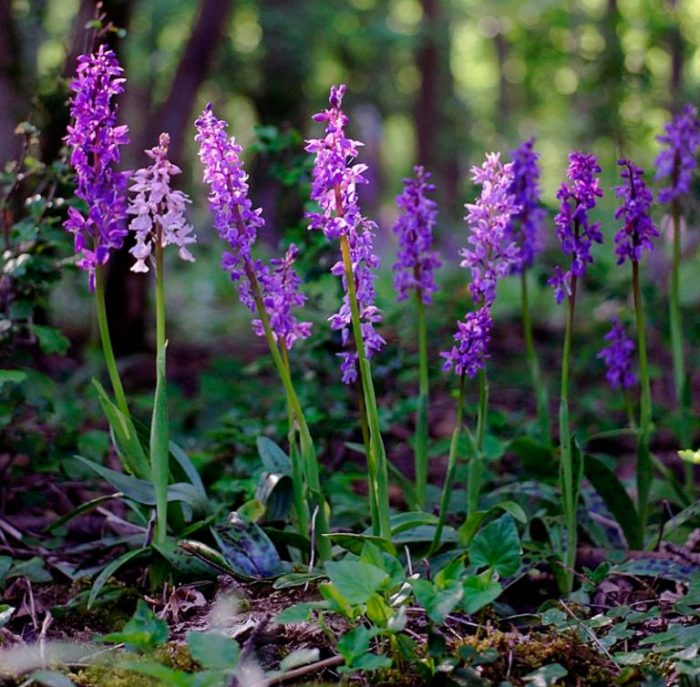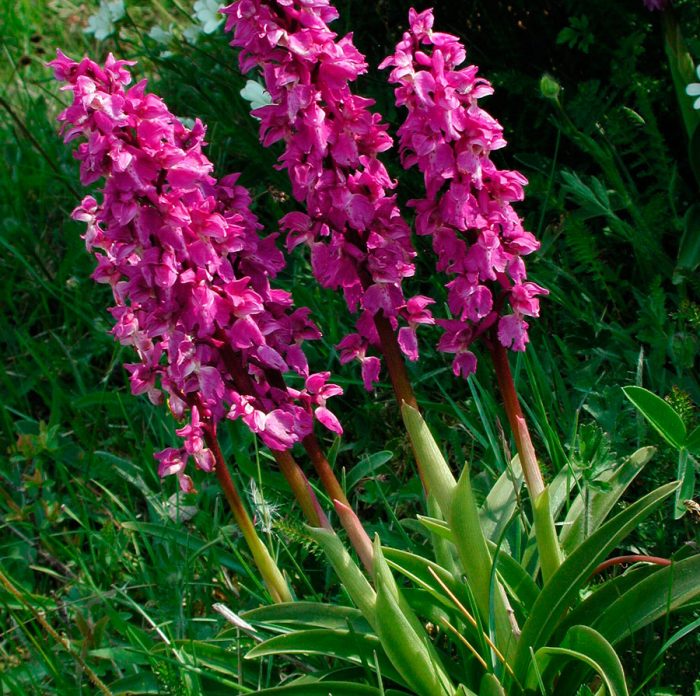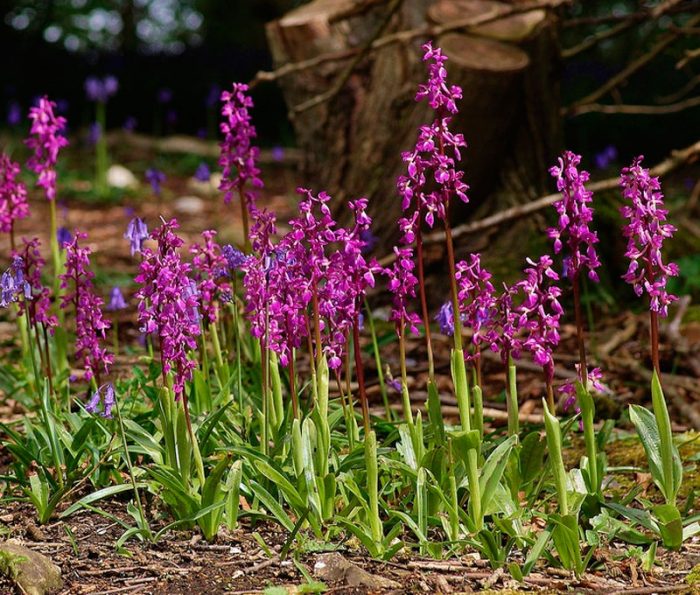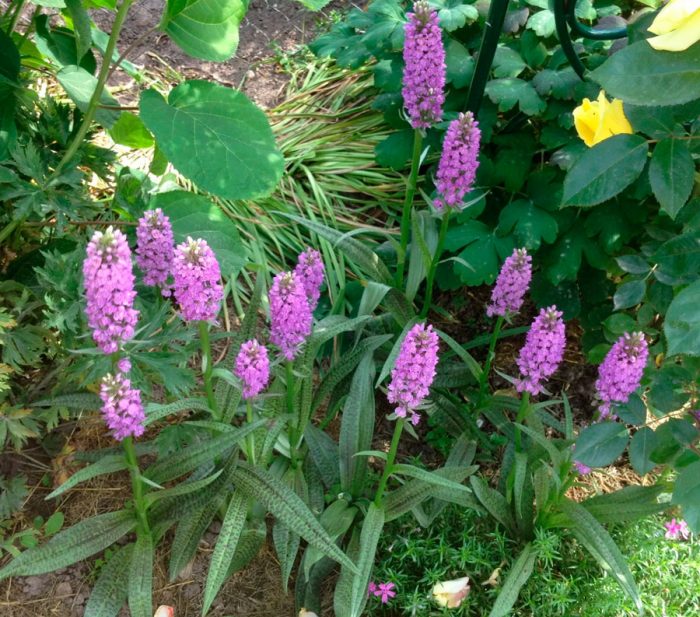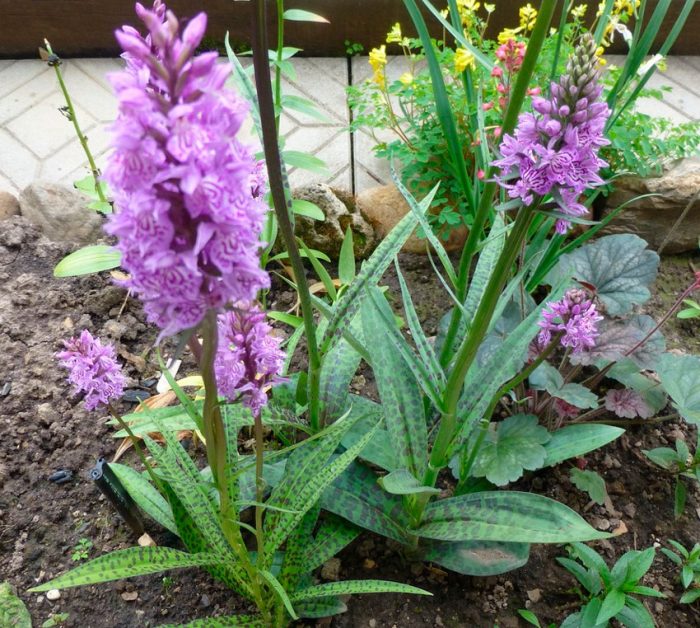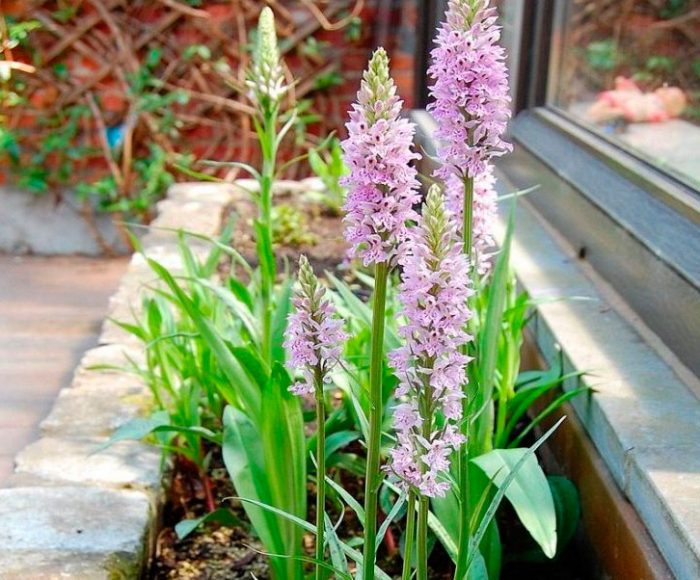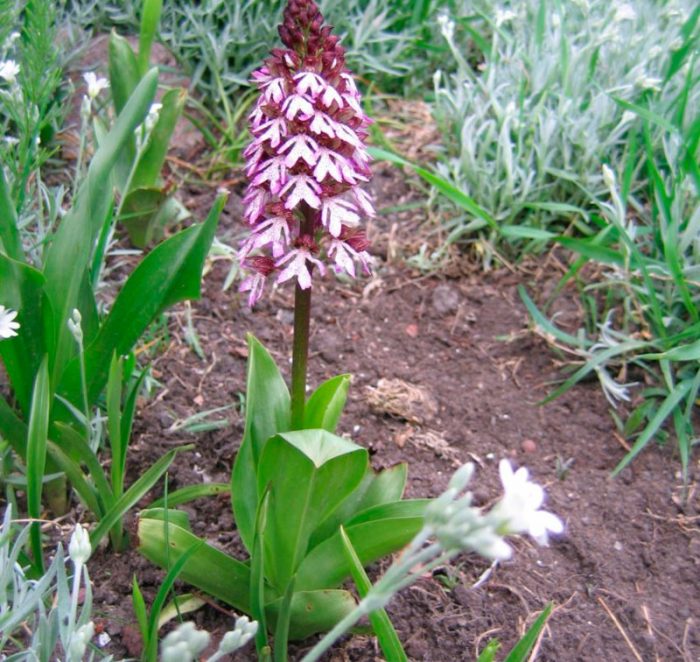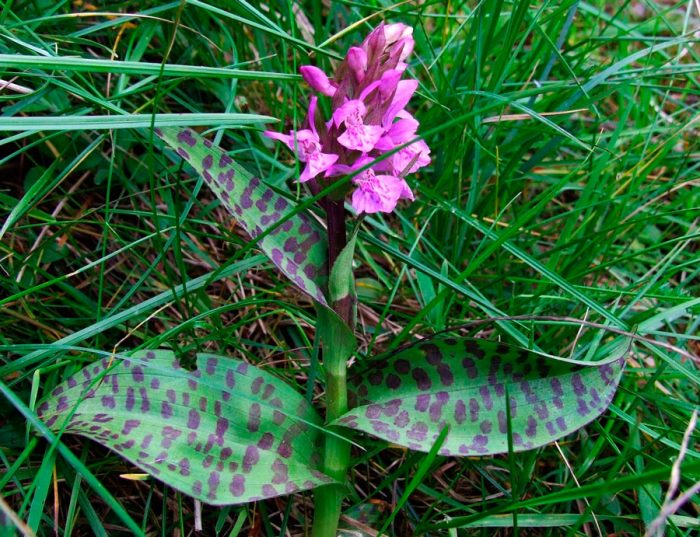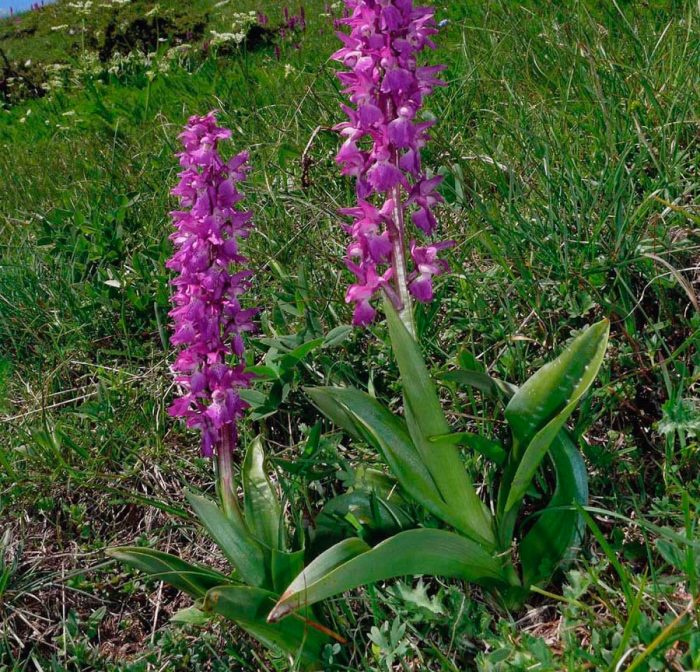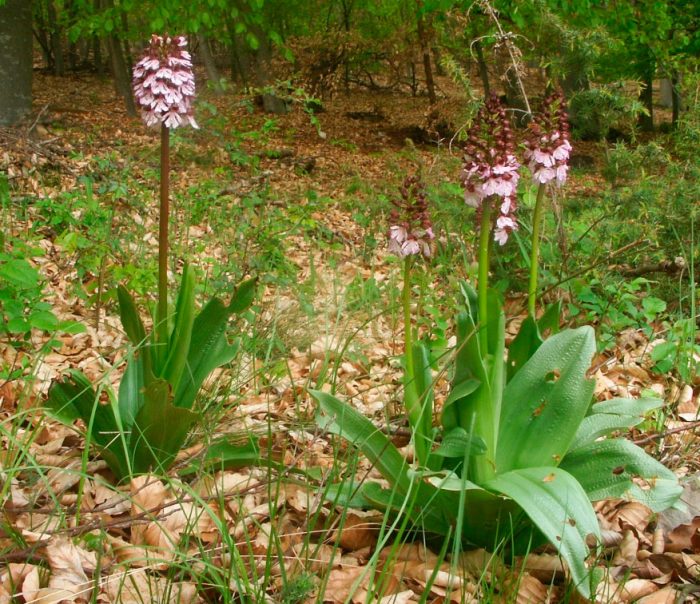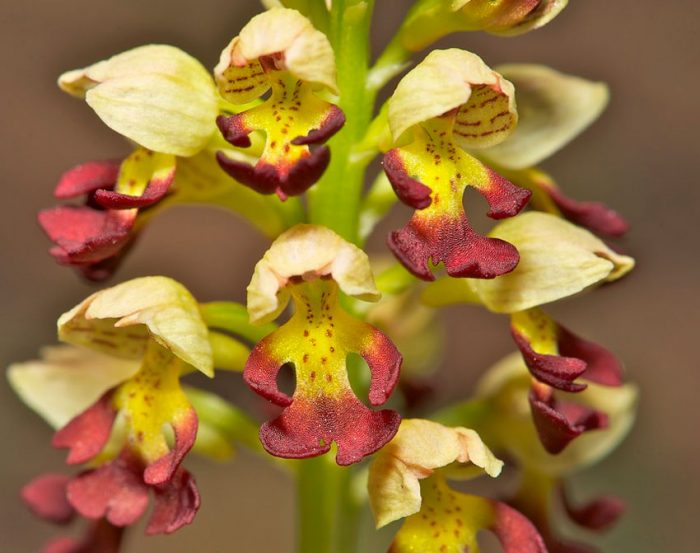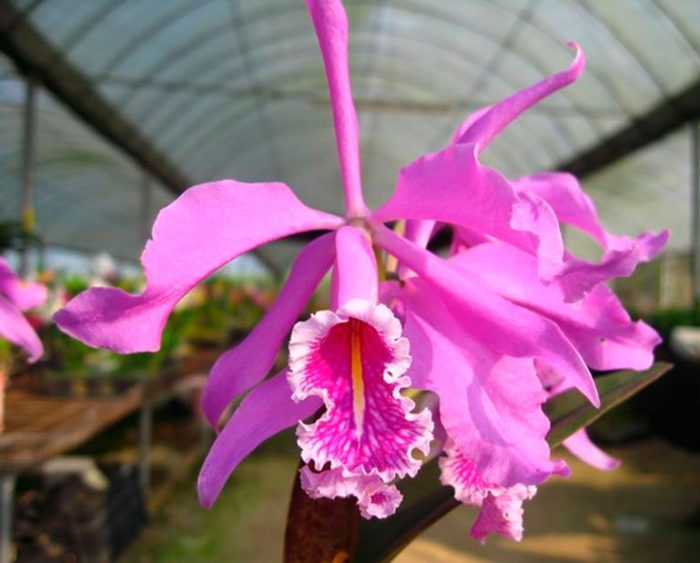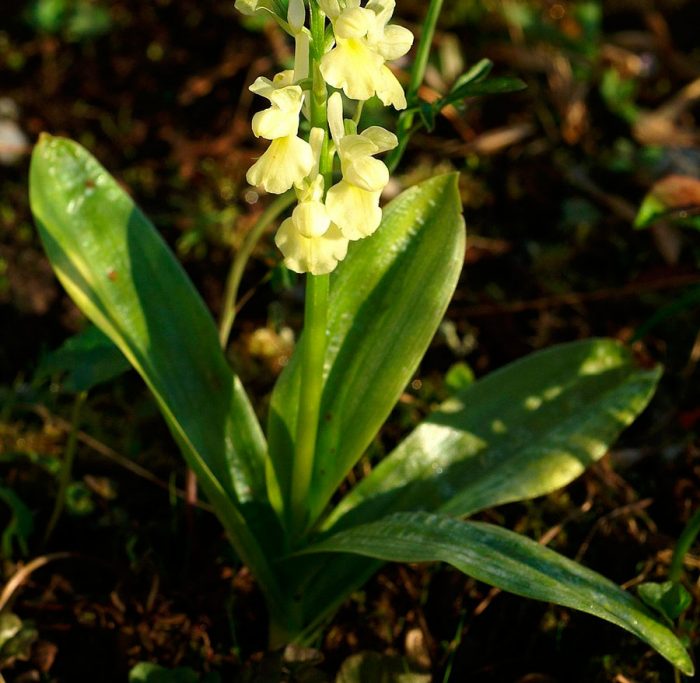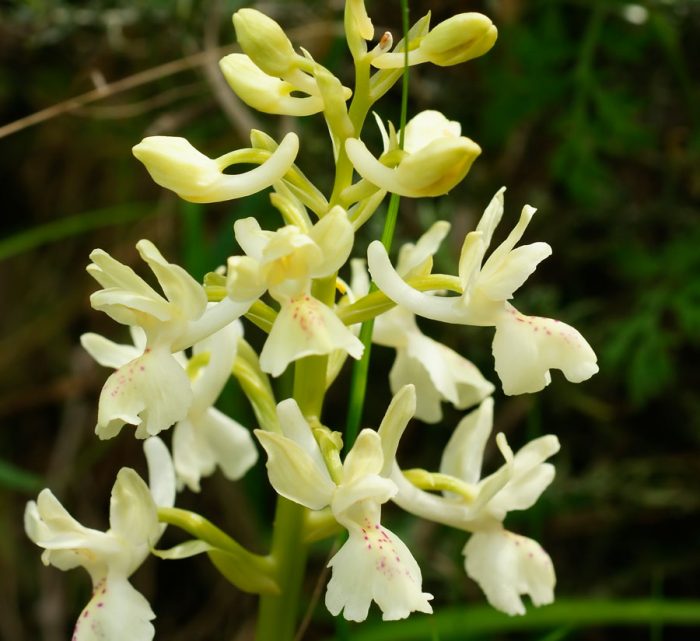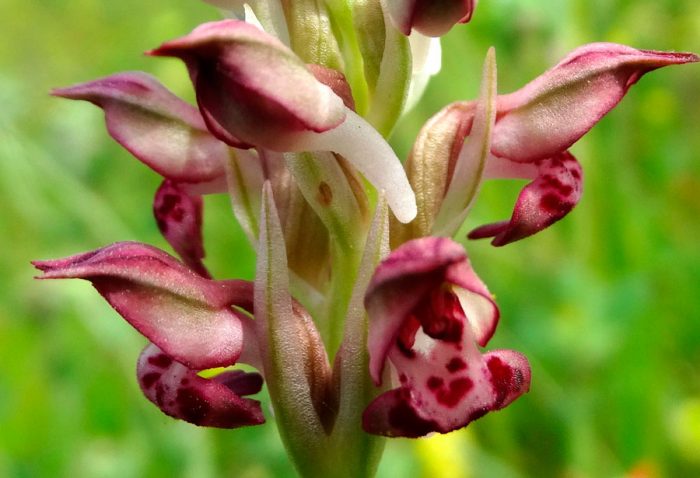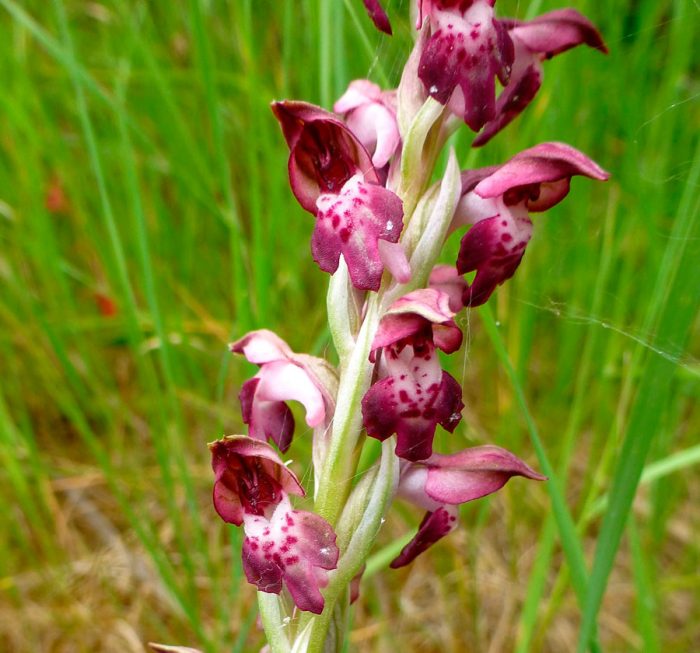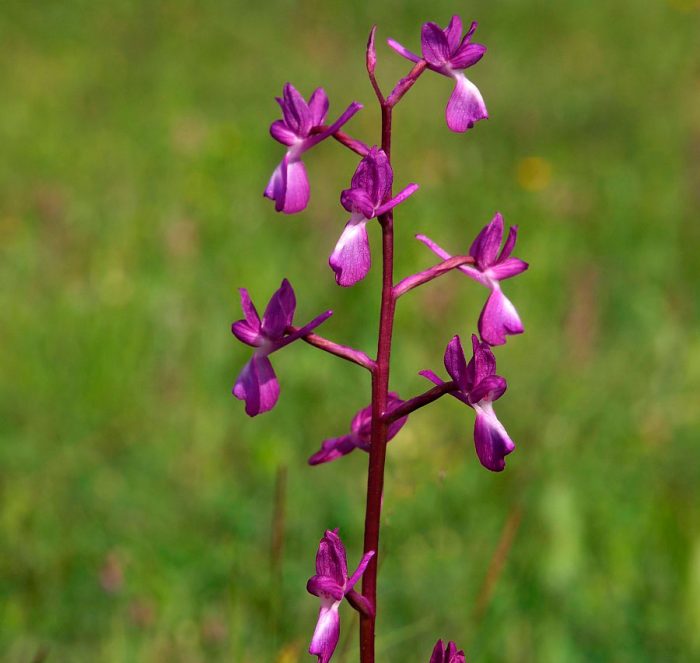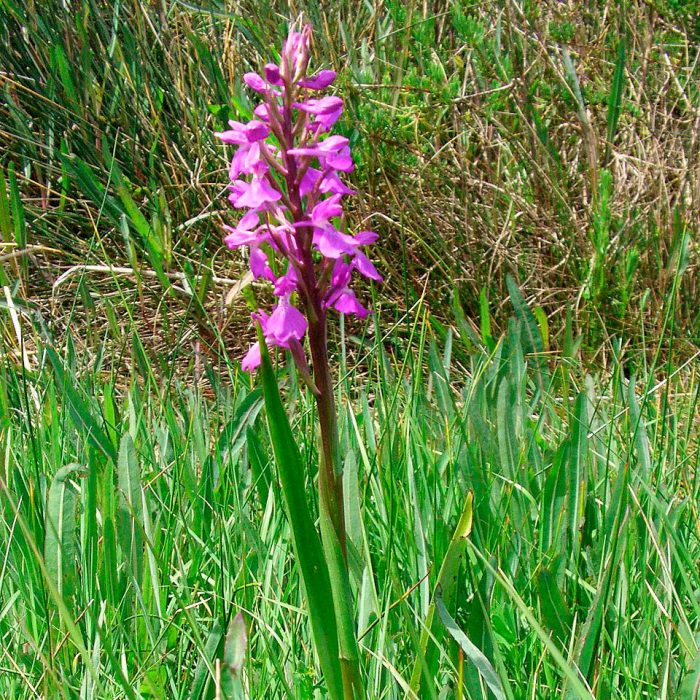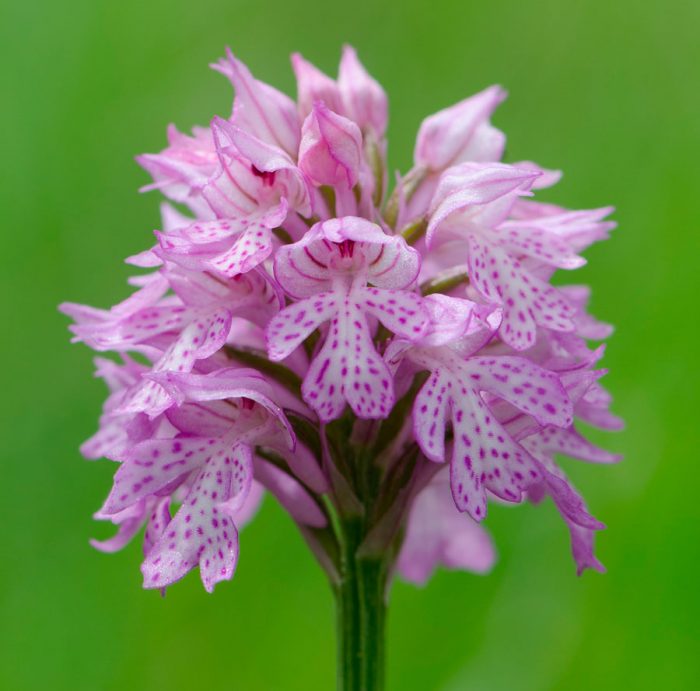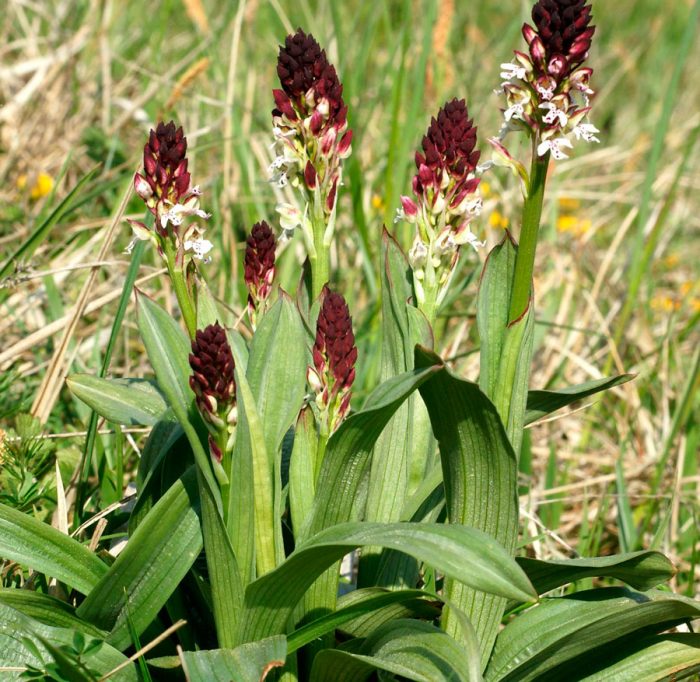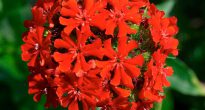It is extremely rare in mid-latitude gardens to meet a wild orchid, which is scientifically called the orchis. Not so long ago, whole thickets of orchis could be found in the forests, but today they are very rare.
Such an unusual perennial plant is listed in the Red Book. However, the orchis has become widespread in culture, and all thanks to its lace inflorescences, the shape of which resembles a candle. It is grown both as an ornamental crop and for obtaining medicinal raw materials. The orchis is quite demanding to care for, but despite this, it is very popular with gardeners.
Content
- 1 Features of the orchis
- 2 Reproduction methods
- 3 Orchis care
- 4 Diseases and pests
- 5 Orchis species with photos
- 5.1 Spotted orchis (orchis maculata)
- 5.2 Male orchis (Orchis mascula)
- 5.3 Purple orchis (Orchis purpurea)
- 5.4 Monkey orchis (Orchis simia)
- 5.5 Small-spotted orchis (Orchis punctulata)
- 5.6 Orchis maxima (Orchis maxima)
- 5.7 Pale orchis (Orchis pallens)
- 5.8 Provencal orchis (Orchis provincialis)
- 5.9 Green-brown orchis (Orchis viridifusca)
- 5.10 Dremlik orchis (Orchis morio)
- 5.11 Orchis (Orchis militaris)
- 5.12 Rod Anacampis
- 5.13 Genus of Neotineus
Features of the orchis
The orchis plant is popularly called the wild orchid, orchis, or cuckoo tears. This Red Book plant can be a real highlight of any garden plot. During the flowering period, such a culture compares favorably with all other garden plants for its unusual beauty.
If you decide to decorate your garden with a wild orchid, then remember that in no case should you look for a seedling in the wild. The fact is that this endangered plant is under state protection. Even if you unexpectedly come across an orchis in the wild, the only thing you can do is admire its beauty.
But in your garden you can freely grow orchards. They were bred by breeders for industrial cultivation, as well as for cultivation as an ornamental plant. Of course, buying a seedling or orchis seeds is not easy, but it is quite possible. Most often, it is enough to order from the catalog. When buying seedlings at the market or from a gardener you know, try to find out where this orchis was grown. The fact is that for participating in the reduction of the population of such a plant in the Red Data Book, you can be punished by law.
The bush reaches a height of about 50 centimeters. The thickened rhizome has an ovoid shape, due to which the plant was called orchis. The bush has many upright shoots that adorn long, lanceolate leaf plates.They taper towards the petiole and seem to "hug" the stem. The foliage shape of orchis and cereals is very similar. However, the wild orchid stands out from many other horticultural crops with its bright green foliage.
For this plant, the Latin name Orchis comes from the ancient Greek ὄρχις, which means "egg". The fact is that a pair of orchis tubers are very similar to testicles. There are several versions of how exactly the Russian name of this plant came about. In etymological dictionaries, there are at least 3 versions of the origin of the name of the orchis:
- it comes from the dialect word "yatro", which translates as "egg";
- the root of this plant was used to prepare a love potion (yatrov flower);
- VI Dal believed that the name came from the word "kernel", which means "core".
In common people this plant is often called "tears" or "cuckoo tears".
Such a plant is most decorative during the flowering period. At this time, tall peduncles grow, on the tops of which spike-shaped inflorescences are formed, their length varies from 15 to 20 centimeters. In each inflorescence several complex flowers, distinguished by high decorativeness, sit tightly. Despite the fact that the size of the flowers is only about 20 mm, their beauty is often compared to orchid flowers. The petals of the inner and outer circle are connected to each other, forming a kind of "helmet". The flower's lip is tripartite, and the petals located below and above can have different sizes and shapes. Often there are specks on the surface of the lip, and the flower looks incredibly elegant because it has a spur, which is equal in size to the ovary.
The duration of flowering depends on the type of orchis and can last from 15 days to several months. In low-growing varieties and species, flowering begins in April – May, and in vigorous ones - in June. In most of the species, the inflorescences cannot be called fragrant, however, a subtle pleasant smell of vanilla emanates from them.
Reproduction methods
Growing from seeds
Orchis seed material can be sown when it is convenient for you (regardless of the season). The first seedlings may appear in one or three months, or it may take longer. In this regard, sowing wild orchids for seedlings can be done even in summer.
Fill the container with moist, nutritious and loose soil. It is necessary to deepen the seeds into the substrate quite a bit. Crops are harvested in a well-lit place, while always providing them with a suitable temperature (18-24 degrees).
As a rule, the appearance of seedlings is uneven, while they also differ in the pace of development. When the plant has several true leaf plates, it is very carefully transplanted into an individual container. When digging up a seedling, try not to injure nearby plants and seeds that have not sprouted. Planting seedlings in the garden is carried out in the spring after age-related frosts are left behind, and warm weather sets in. Orchis seedlings are planted in such a way that there is a distance of at least 10-15 centimeters between the bushes.
Rhizome division
Orchis can be propagated by separating the replacing tuber. This method is most popular among gardeners, as it is distinguished by its simplicity and reliability.
In the autumn, after the aerial part of the bush is cut off, remove the rhizome from the ground and separate the replacing root tuber from it. When planting a cut in a new hole, do not forget to pour soil from the old hole into it. The fact is that in this soil there are special fungi, without which the division may not take root. And it will be better for the plant the more soil you take from the old hole.
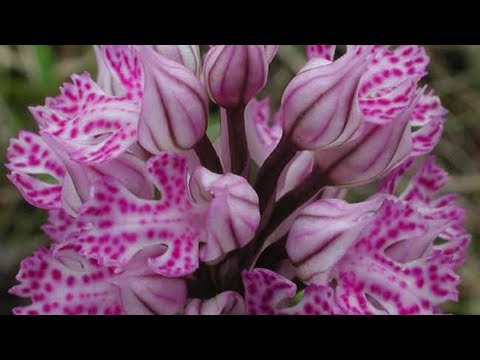

Watch this video on YouTube
Orchis care
Orchis, which is also called the wild orchid, grows well in the open field.Moreover, in garden varieties, flowering is more spectacular than in wild plants. However, in order for the bushes to bloom magnificently and for a long time, optimal conditions for their growth should be created.
Lighting
Best of all, such a flower grows in light partial shade, while the lighting should be diffused. Unlike wild species, garden varieties grow well in sunny areas, the only thing they cannot be planted in the shade. But at the same time remember, the more sunlight on the site, the more difficult it is to care for such a plant.
Priming
Orchis will grow well only on nutritious and moist soil, and it should be very loose. It must also be well drained. Pay particular attention to soil moisture. The wild orchid reacts extremely negatively to the stagnation of liquid in its roots, but it prefers to grow in moist, cool soil, and it must remain so even on hot summer days. Worst of all, such a flower grows in dense soil, as well as in soil fertilized with fresh manure. When preparing a hole for planting a plant, it is recommended to mix the soil pulled out of it with peat (1 part) and with sand (0.5 parts).
Watering
The orchis grown in a well-lit area needs systematic timely watering. If the plant is rarely watered, then the flowering will be poor and short-lived. And it is also necessary to water regularly those bushes that are grown in an area with depleted soil.
In the event that moist, loose soil was chosen for planting such a flower, then it will need to be watered only if necessary. During periods of prolonged drought, be sure to water the wild orchid, preventing the soil from drying out and overheating.
Watering such a crop is necessary in such a way that the soil on the site is constantly slightly moist. The plant is equally harmed by overdrying of the earth and stagnation of liquid in the root system.
Fertilizer
It is highly undesirable to feed the garden orchis with mineral fertilizers. For a spectacular and lush flowering, the bushes are recommended to be fed with organic fertilizers. They not only compensate for the lack of nutrients in the soil, but also improve its structure.
Needles and compost are great for feeding such a plant. They are recommended to be introduced into the ground during the preparation of the site for planting the orchis. They are also used as mulch; for this, the soil surface around the bushes is covered 2 times during the season with a thick mulch layer (at least 50 mm). It is recommended to mulch the bushes in the middle of spring and in the first days of September.
Wintering
Wild orchid is not a thermophilic plant. It is characterized by a fairly high resistance to frost and is able to survive the winter without shelter even in mid-latitudes.
Despite this, the plant must be prepared for wintering, as it may suffer due to stagnant moisture in the soil, as well as due to sudden temperature changes during a thaw.
Orchis preparation should be done in autumn. When you notice that the above-ground part of the bush has begun to dry out, it must be completely cut off to the very base. At the same time, it is extremely undesirable to wait until the stems are completely dry and die themselves. All experienced gardeners recommend that it is imperative to carry out a cardinal pruning, without fear of harming the plant. After pruning, the root system will be well prepared and will not be afraid of any winter.
Diseases and pests
Orchis are incredibly resistant to various diseases. They are not affected by fungal diseases, and most of the pests are not afraid of them.
The only thing that can harm a wild orchid is various leaf-eating pests, for example: slugs, snails, etc. That is why it is recommended to install special traps next to flowers or spread straw circles.
Orchis species with photos
The genus Yartyshnik unites about 100 different species, which are similar in type of flowering.Most of the species and varieties are highly decorative and are grown outdoors.
Spotted orchis (orchis maculata)
This species is the most popular among gardeners. However, experts to this day argue about which species this plant belongs to. The fact is that its roots are finger-separate, and in almost all other species of orchis they are ovoid.
Most experts today attribute this plant to the species dactylorhiza maculata. However, there are no special differences between these plants, only leaf plates of greater width and a wider palette of colors. It is necessary to care for such plants in the same way. Today this plant is included in one and another genus at the same time.
It does not matter how the given plant is called, and what genus it belongs to, because it has a very high decorative effect. The roots of this herbaceous perennial plant are finger-like and thickened. The height of its stems can vary from 0.15 to 0.6 m. This flower looks very impressive and graceful. The slender curtain consists of erect stems and lanceolate-ovate leaf plates, tapering into a petiole and covering the shoots.
At the tops of leafy stems are peduncles, on which inflorescences are formed, having the shape of an ear. In highly decorative flowers, the lip is three-lobed, and the spur is conical. They have a rather unusual color: white, lavender or bright purple with small spots of a dark shade. Often, the leaf plates of such a plant are decorated with an unusual pattern. Flowering begins in mid to late May. Its duration depends on the growing conditions of the plant and can be equal to 15–30 days.
Of the basic species of orchis in the open field, those described below are cultivated.
Male orchis (Orchis mascula)
This type is one of the most highly decorative. The surface of its foliage and shoots is decorated with spectacular specks of purple hue. The inflorescences consist of lovely flowers of a pink-purple hue, in which a deeply incised lip is clearly visible, while at its base there is a spectacular white blurred spot. Also, the flowers are decorated with small specks of a dark shade. Flowering begins in April or May. This species is often used by breeders to develop new varieties and hybrids.
Purple orchis (Orchis purpurea)
Its peduncles have a brown color, wide lily-of-the-valley leaf plates are painted in a rich green color. The dense, spike-shaped inflorescence looks more like a fringe. In snow-white flowers, the large lip has a flattened shape, while it is deeply dissected. The flowers are decorated with many small dots of a dark shade.
Monkey orchis (Orchis simia)
Dense inflorescences have a pyramidal shape, and they look lacy. The bush reaches a height of about 50 cm, its leaf plates are long, and the flowers smell of honey. They consist of elongated petals of a faded, almost white color. The flowers are decorated with spectacular specks, and they have stripes along the edge. Outwardly, the flower is very similar to a monkey's face.
Small-spotted orchis (Orchis punctulata)
The bush is decorated with rich green foliage, as well as spectacular inflorescences of a light green hue.
Orchis maxima (Orchis maxima)
This species differs from the rest in that it is the tallest: the height of the bush is about 0.7 meters. Fragrant strong inflorescences consist of flowers, the lip and helmet of which are decorated with small specks. There is a deep indentation on the lip, while the color of the flowers is unusual: it differs in watercolor transitions from pale white to purple. Today, such a plant is not considered a separate species, it is a variety of purple orchis (Orchis purpurea).
Pale orchis (Orchis pallens)
A short bush, as a rule, reaches no more than 0.3 m in height. Quite wide leaf plates of an obovate shape are about 11 centimeters long.Lush spiky inflorescences consist of large flowers of light orange, deep yellow or purple color. The bracts are lanceolate, and their smell is very unusual, somewhat similar to an elderberry.
Provencal orchis (Orchis provincialis)
The foliage of this species is decorated with dark spots. Loose inflorescences consist of large, whitish-yellow flowers, the surface of which is covered with dark specks.
Green-brown orchis (Orchis viridifusca)
This plant is a subspecies of the Spitzel Orchis (Orchis spitzelii). The bush reaches a height of about 0.3 m, its wide leaf plates are painted in a marsh shade. Narrow elongated spike-shaped inflorescences consist of purple flowers with greenish color, which have a large lip and a spectacular helmet. This also includes the greenish-yellow Orchis (Orchis chlorotica, or Anacamptis collina), which is a fellow of the green-brown Orchis, their inflorescences are light green-yellow.
Dremlik orchis (Orchis morio)
This species is able to compete with violets. Its height varies from 15 to 20 centimeters. In the lower part of the stems, pale gray leaf plates grow. During flowering, short spike-shaped inflorescences with spectacular purple-lilac flowers are formed. In their shape, the flowers are very similar to the muzzle of a bull terrier. The peculiarity of this species is also that for the first two years the flower lives underground. Only in the third year of growth do peduncles and foliage grow above the ground.
Orchis (Orchis militaris)
The flowers are decorated with a variegated purple-white lip, it has very thin lobes. The pinkish helmet is much larger than the lip.
Some of the species cultivated by gardeners as orchis actually belong to such genera as Neotinea and Anacamptis, which are also part of the Orchidaceae family. In the literature, such plants can often be found both under the new and under the old name, for example: Neotinea tridentata, or Neotinea tridentata.
Rod Anacampis
Orchis (Orchis coriophora)
The height of the bush can vary from 0.2 to 0.4 m. The narrow leaf plates are lanceolate. The cylindrical elongated inflorescences consist of flowers, the lip of which is deeply dissected, and there is also a pointed helmet. The color has complex transitions from brownish-purple with purple specks at the top of the petals to white and pale green at the base.
Veinous orchis (Orchis nervulosa)
It is very similar to the previous species, but its flowers smell more pleasant, and on the surface of the narrow leaf plates there is a pattern of dark veins.
Fragrant orchis (Orchis fragrans)
The height of the bush is about 50 cm. Its purple flowers are collected in openwork inflorescences. They smell nice of vanilla, and are decorated with a spectacular helmet and a rather long median lobe on the lip.
Orchis (Orchis laxiflora)
His inflorescences are thin, almost double-sided. They are composed of purple flowers.
Orchis pseudolaxiflora (Orchis pseudolaxiflora)
It is a subspecies of loose-flowered orchis. It blooms very early. The height of the bush is about 0.6 m, high inflorescences are formed, which consist of widely spaced flowers of a deep purple color.
Marsh orchis (Orchis palustris)
Outwardly similar to the previous view. Its height is about 0.7 m, while its leaves are graceful and long. Lacy loose inflorescences include lilac flowers, which are decorated with a large lip, similar to a skirt. Flowering begins in May – June.
Caspian orchis (Orchis caspia)
Such a miniature plant during flowering is decorated with a loose, elongated inflorescence, consisting of dark purple flowers.
Spotted orchis (Orchis picta)
The bush reaches a height of about 0.3 m, it is distinguished by flowers of a dark purple hue.
Genus of Neotineus
Orchis tridentata (Orchis tridentata)
On the bush, dense inflorescences are formed with an almost spherical shape. The flowers have a pale lilac color.
Orchis (Orchis ustulata)
Dense, spike-shaped inflorescences look like a mace and consist of pale pink flowers. The height of the bush is about 0.3 m.
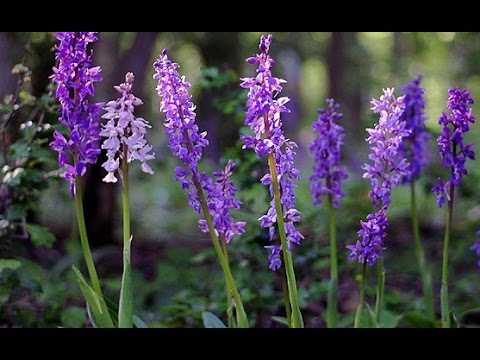

Watch this video on YouTube

